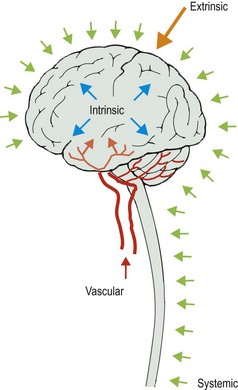Pathological processes in neurology
It is useful to appreciate the ways in which the nervous system malfunctions. This is important clinically because the time course of any pathological process is described by the patient in the history. It also provides a framework for understanding different types of disease, particularly rarer diseases that you might not otherwise know about.
Broadly, pathological processes can be divided into (Fig. 1):
Hint: remember this as SIVE. There is some overlap between these categories.
Vascular
The nervous system can be affected by vascular disease in two ways:
With the exception of subdural haematoma, these are characterized by a sudden onset.
Extrinsic
Every level of the nervous system can be affected. Some of the processes are summarized in Table 2.
Table 2 Extrinsic pathological processes classified according to the level of the nervous system affected
| Level of nervous system | Pathological process |
|---|---|
| Brain |
Intrinsic
These processes can be divided into:
This can be remembered as MIND PIG.
Infectious
Less common infections include Lyme disease, human immunodeficiency virus infection and its complications, human T-cell leukaemia virus 1 myelopathy and Creutzfeldt–Jakob disease. These are discussed on pages 98–101.
Degenerative
Degenerative diseases of the nervous system (Table 3) are progressive; some are familial but most are of uncertain aetiology. In some, a genetic cause has been found, for example Huntington’s disease. All levels of the nervous system can be affected. These conditions are grouped together for convenience. When the underlying pathophysiology of these conditions is better understood they may be further reclassified as genetic or metabolic diseases.
| Level of nervous system | Syndrome |
|---|---|
| Brain |
















